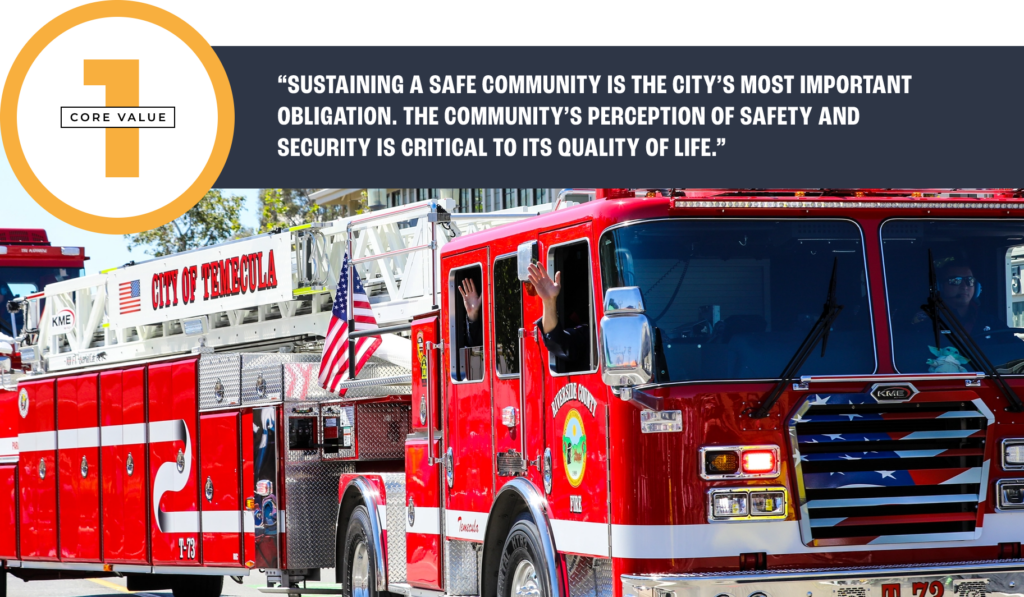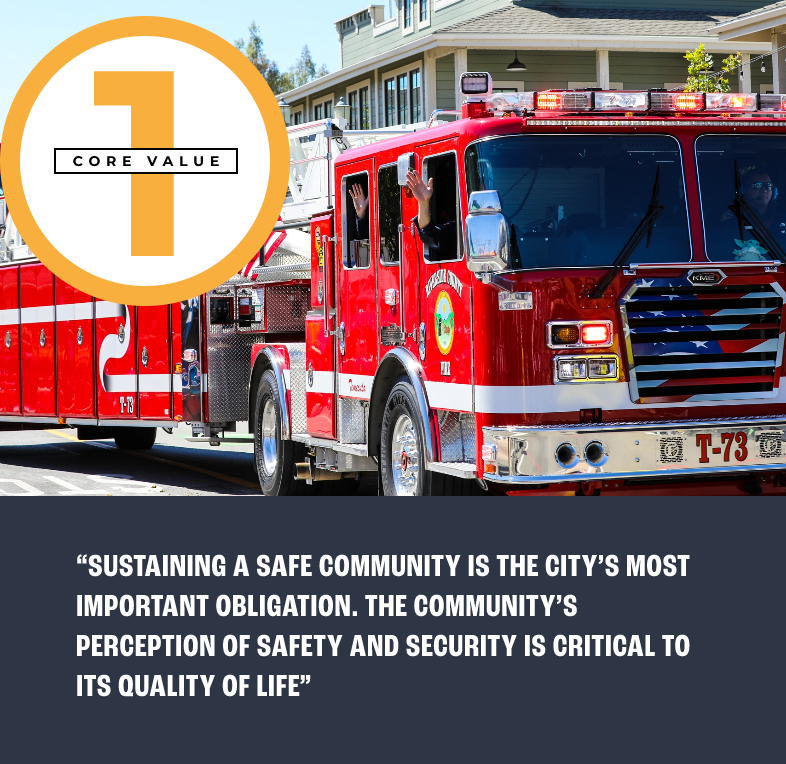Safe & Prepared Community
Safe & Prepared Community


Safe & Prepared Community
It is important to address and prevent both the reality and perception of disorder within the community. A safe community is one that has low crime rates; responsive police, fire and emergency services; safe routes of travel for those on bikes and pedestrians, well publicized emergency evacuation routes; well-maintained properties and spaces; and a strong sense of community that enhances the perception and experience of safety and well-being.
The City’s approach to police protection continues to evolve to meet the ever changing needs of its residents and businesses. The City has implemented Community Policing which provides for continuity in police personnel so they can better get to know the neighborhoods they patrol. The City has established the Old Town Metro Team, which is comprised of dedicated deputies who provide added engagement with business owners, employees, visitors, and residents of the Old Town area. The deployment of the team helps improve enforcement efforts and enhance relationships with the community and visitors on a daily basis.
The Old Town Metro Team is also supported by Code Enforcement, Building and Safety, and Fire Inspection personnel, so that health and safety issues can be addressed in a proactive way.
The City also participates in the Community Behavioral Health Assessment Team (CBAT) that includes social workers and mental health professionals. The City has a very effective Homeless Outreach Team with the mission to connect homeless individuals with services as well as to enforce the law.
Communities and residents also need to be well prepared for natural and other disasters, as wildfires in the region have shown, with effective emergency communications and response systems. The City has hired an Emergency Manager and plans to undertake the creation of a comprehensive Emergency Management Master Plan. Important elements of this planning process include upgrading the City’s Emergency Operations center (EOC), establishing secondary/alternate EOCs, upgrading the technology used by the public safety communications system and establishing citywide Shelter in Place and Mass Evacuation Plans. In addition, training citizens to increase resiliency in case of emergency is an extremely effective strategy and remains an ongoing priority for the Fire Department and the Office of Emergency Management.
The City’s approach to police protection continues to evolve to meet the ever changing needs of its residents and businesses. The City has implemented Community Policing which provides for continuity in police personnel so they can better get to know the neighborhoods they patrol. The City has established the Old Town Metro Team, which is comprised of dedicated deputies who provide added engagement with business owners, employees, visitors, and residents of the Old Town area. The deployment of the team helps improve enforcement efforts and enhance relationships with the community and visitors on a daily basis.
Measuring Our Progress
| Indicator | Meets/Exceeds Goals | Progressing | Needs Improvement |
|---|---|---|---|
| Number of Police Officers: Goal is 1 officer per 1,000 residents “Progressing” is 0.90-0.99 per 1,000 residents, and “Needs Improvement” is less than .90 officers per 1,000 residents | More than 1 officer per 1,000 residents | ||
| Average response time for police for Priority I Crimes: Goal: 5 minutes or less “Progressing” is 5-6 minutes response, and “Needs Improvement” is more than 6 minutes* of Police Officers: Goal is 1 officer per 1,000 residents “Progressing” is 0.90-0.99 per 1,000 residents, and “Needs Improvement” is less than .90 officers per 1,000 residents | 4.96 minutes average response time (2021) |
| Indicator | Meets/Exceeds Goals | Progressing | Needs Improvement |
|---|---|---|---|
| FBI rating for Safest Cities in America: Goal: Be in the top ten; “Progressing” is 11-25 safest cities; “Needs Improvement” is 25+ safest cities | Ranked 16th safest city in America | ||
| Number of violent crimes per 100,000 residents: Goal: decreasing crimes more than 2.5%; “Progressing” is no increase in crimes (0-2.5%); “Needs Improvement” is increase in crimes more than 2.5% | 166 crimes per 100,000 population, up from 153 in 2010 (3.5% increase) | ||
| Number of property crimes per 100,000 residents: Goal: decreasing crimes more than 2.5%; “Progressing” is no increase in crimes (0-2.5%); “Needs Improvement” is increase in crimes more than 2.5% | 2,626 crimes per 100,000, down from 2,834 in 2010 (7.3% decrease) |
| Indicator | Meets/Exceeds Goals | Progressing | Needs Improvement |
|---|---|---|---|
| Effective response time for fire protection: Goals: 5 minutes or less, 90%+ of the time; “Progressing ” is 80-89% of the time; “Needs Improvement” is less than 80% of the time | 90% of response times (2021) | ||
| Effective response time for ambulance, emergency services: Goals: 10 minutes or less; “Progressing ” is 10-12 minutes; “Needs Improvement” is > 12 minutes | Less than 10 minutes | ||
| ISO Fire Insurance Rating: Goal: <3 ISO rating; "Progressing" is 3-3.5 ISO rating; "Needs Improvement" is 4+ ISO rating | 2 Rating |
| Indicator | Meets/Exceeds Goals | Progressing | Needs Improvement |
|---|---|---|---|
| Number of citizens trained in CPR, First Aid and healthcare provider CPR and Stop the Bleed program: Goal 850 per year; “Progressing” is 500-850 per year; “Needs Improvement” is <500 per year | 633 | ||
| Number of citizens trained in Community Emergency Response Team Training (CERT): Goal 175 per year; “Progressing ” is 100-175 per year; “Needs Improvement” is <100 per year | 139 | ||
| Number of new enrollees per year in themass notification system: Goal: 7,000 (20%) households per year; “Progressing” is 3,500-7,000 (10-20%); “Needs Improvement” is <3,500 (10%) | 3,000 registrants | ||
| Number of partnerships developed with key community stakeholders – public and private partners, non-profits, tribal government, community groups, faith-based organizations, and schools – to enhance emergency preparedness, response and recovery within the City of Temecula. Goal=7-10, “Progressing” is 4-6; “Needs Improvement” is <4 Number of partnerships developed with key community stakeholders – public and private partners, non-profits, tribal government, community groups, faith-based organizations, and schools – to enhance emergency preparedness, response and recovery within the City of Temecula. Goal=7-10, “Progressing” is 4-6; “Needs Improvement” is <4 | 7 |
| Indicator | Meets/Exceeds Goals | Progressing | Needs Improvement |
|---|---|---|---|
| Overall traffic safety for driving, cycling, walking: CA Office of Traffic Safety rating for cities with 100,000-250,000 populations: Goal: to rank in the top 10 cities; “Progressing” is in the top 11-20 cities; “Needs Improvement” is 20+ cities ranking | Ranks #21 |
| Indicator | Meets/Exceeds Goals | Progressing | Needs Improvement |
|---|---|---|---|
| Remove graffiti within 24 hours: Goal: 90% of the time; “Progressing” is 80-89% of the time; “Needs Improvement” is 79% or less of the time | 95% |
Our Accomplishments, Strategic Objectives, and Goals for 2040
- Implemented community policing which provides for continuity in police personnel so they can better get to know the neighborhoods they patrol
- Established the Metro Team, which includes Sherrif’s Deputies supported by Code Enforcement, Building and Safety, and Fire Inspection personnel so that crime prevention can be addressed in a proactive and holistic approach
- Participation in the Community Behavioral Health Assessment Team (CBAT) that includes social workers and mental health professionals
- Very effective Homeless Outreach Team (HOT) with the mission to connect homeless individuals with services as well as to gain compliance with the law
- Purchased a new ladder truck in 2021
- Installed personal thermal imaging cameras for every seat on each of Temecula’s fire engines and truck companies
- Filled the Emergency Manager position to run the Office of Emergency Management
- Renovations to Fire Station 84 located on Pauba Road. This renovation will include a new state of the art training facility to ensure our community is prepared
- Over the next two years, complete an addition to Fire Station 73 to add two additional bays to store the Urban Search and Rescue (USAR) and medical squad/swift water rescue vehicle. This addition will also include adding a gym to the facility
- Introduce new pre-planning programs and training tools for the Fire Department. The City of Temecula strives to be on the cutting edge on ways to respond to emergency incidents
- Acquire Fire Station 12 from the State and update it to be a state of the art fire station that will continue to serve the Old Town area
- A new fire training facility
- Monitor need for a second ladder truck as highrise development intensifies
- Continuous updates to Emergency Preparedness and Response Plans, and upgrades to technologies at the City’s existing Emergency Operation Centers (EOCs) located at City Hall and the Library
- Implement Emergency Preparedness Programs to train citizens to be prepared in case of an emergency
- Wildfire Mitigation Fuel Management Program
- Neighborhood and City Facility Fire Hardening Program
- Continue to be one of the safest cities in California and the nation
- Ensure that funding for public safety remains the highest priority
- Maintain a ratio of one police officer per 1,000 population
- Support community oriented policing and maximize community leadership in public safety
- Achieve a City ISO rating of 1.0 (i.e. most exemplary level)
- Maintain a five minute or less response time for fire protection
- Minimize impact to life, property and the environment from natural hazards and emergency situations by maintaining a high level of emergency management planning, facilities and technology, including coordination with regional partners
- Provide recreational and other activities for youth that promote socially productive behavior
- Provide effective enforcement of City zoning, building, fire and grading codes, and graffiti abatement
- Continue to provide a high-level of public information and training for the community surrounding emergency management and public safety
Community Survey
The survey acts as the City’s report card from the community. The purpose of the study is to assess perceptions of quality of life in the City and identify important issues and services. The survey gathers opinions on topics and has the residents rate the topics by level of priority (high priority vs. lower priority). It also evaluates perceptions of local government and customer services by rating the expectation level (exceeds expectations vs. not satisfied).
Exceeds Expectations or is a High Priority (>85%)
Progressing or is a Medium Priority (70-84%)
Not Satisfied or is a Lower Priority (<70%)
Police Protection
93.9%
Resident importance to maintain low crime rate
79.6%
Resident satisfaction with Temecula’s crime rate
76.0%
Resident importance to provide neighborhood police patrols
69.5%
Resident satisfaction with neighborhood police patrols
74.7%
Resident satisfaction with enforcement of traffic laws
Fire Services
92.0%
Resident importance to provide fire protection and prevention services
96.5%
Resident satisfaction with fire protection and prevention services
95.6%
Resident importance to provide emergency paramedic services
94.6%
Resident satisfaction with emergency paramedic services
Prevention strategies are a more effective and a more cost-efficient means of sustaining a safe and secure community. This includes creating an attractive, stimulating, and safe environment for teens and young adults. Residents also expressed their desire to travel safely throughout the City on various modes of travel, including bike, pedestrian, equestrian trails and on complete streets.